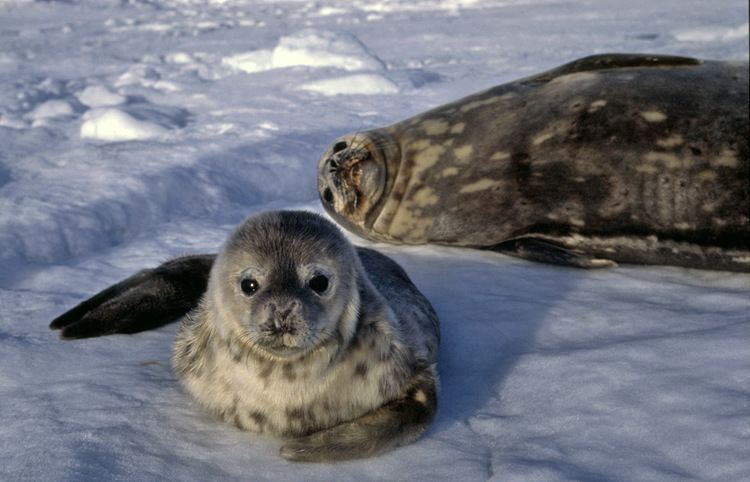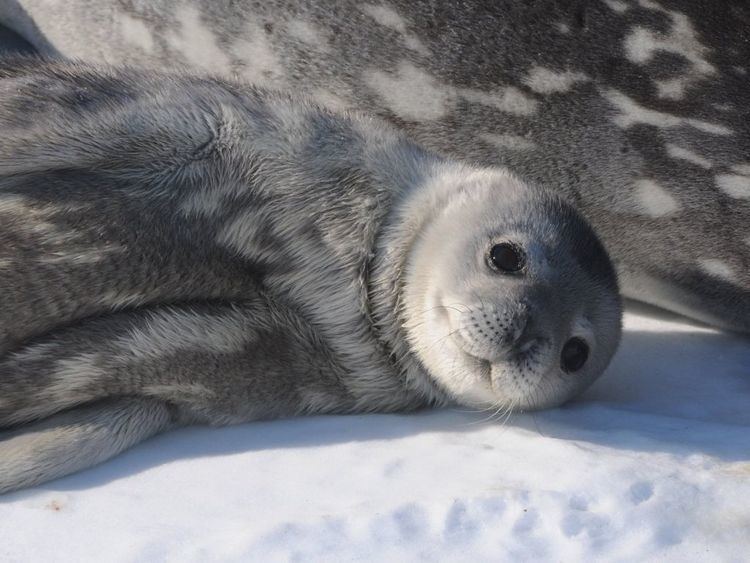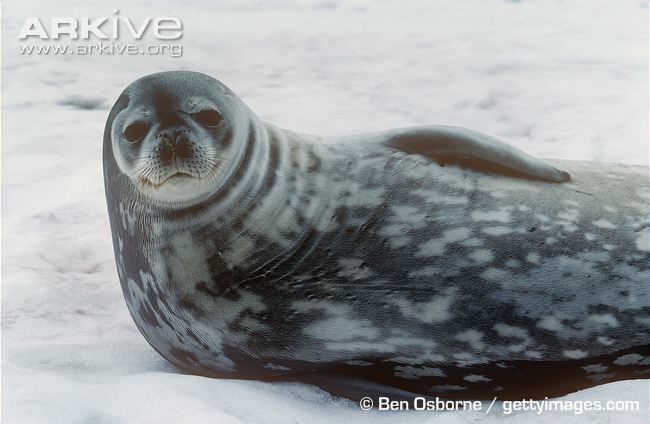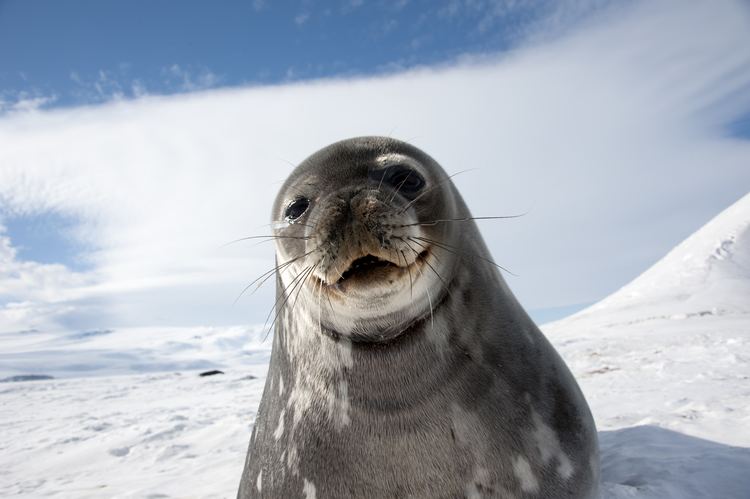Family Phocidae Scientific name Leptonychotes weddellii Rank Species | Phylum Chordata Tribe Lobodontini Higher classification Leptonychotes | |
 | ||
Similar Earless seal, Crabeater seal, Leopard seal, Mammal, Ross seal | ||
Beautiful weddell seal yawning and eating snow in antarctica animals in hd
The Weddell seal, Leptonychotes weddellii, is a relatively large and abundant true seal (family: Phocidae) with a circumpolar distribution surrounding Antarctica. Weddell seals have the most southerly distribution of any mammal, with a habitat that extends as far south as McMurdo Sound (at 77°S). It is the only species in the genus Leptonychotes, and the only member of the Antarctic tribe of lobodontine seals to prefer in-shore habitats on shore-fast ice over free-floating pack ice. Genetic evidence suggests that Weddell seal population numbers may have increased during the Pleistocene. Because of its abundance, relative accessibility, and ease of approach by humans, it is the best-studied of the Antarctic seals. An estimated 800,000 individuals remain today. A genetic survey did not detect evidence of a recent, sustained genetic bottleneck in this species, which suggests that populations do not appear to have suffered a substantial and sustained decline in the recent past. Weddell seal pups leave their mothers at a few months of age. In those months, they are fed by their mothers' warming and fat-rich milk. They leave when they are ready to hunt and are fat enough to survive in the harsh weather.
Contents
- Beautiful weddell seal yawning and eating snow in antarctica animals in hd
- Weddell seal breathing through a hole in the antarctic sea ice animals in hd
- Taxonomy and evolution
- Physical traits
- Behavior and breeding
- Diving
- Diet and predation
- Habitat
- References

The Weddell seal was discovered and named in the 1820s during expeditions led by James Weddell, the British sealing captain, to the parts of the Southern Ocean now known as the Weddell Sea. However, it is found in relatively uniform densities around the entire Antarctic continent.

Weddell seal breathing through a hole in the antarctic sea ice animals in hd
Taxonomy and evolution

The Weddell seal shares a common recent ancestor with the other Antarctic seals, which are together known as the lobodontine seals. These include the crabeater seal (Lobodon carcinophaga), the Ross seal (Ommatophoca rossii), and the leopard seal (Hydrurga leptonyx). These species share teeth adaptations including lobes and cusps useful for straining smaller prey items out of the water. The ancestral Lobodontini likely diverged from its sister clade, the Mirounga (elephant seals) in the late Miocene to early Pliocene, when they migrated southward and diversified rapidly to form four distinct genera in relative isolation around Antarctica.
Physical traits

Weddell seals measure about 2.5-3.5 m (8.2-11.5 ft) long and weigh 400–600 kg (880-1360 lb). Males weigh less than females, usually about 500 kg (1100 lb) or less. Male and female Weddell seals are generally about the same length, though females can be slightly larger. However, the male seal tends to have a thicker neck and a broader head and muzzle than the female. A molecular genetic based technique has been established to confirm the sex of individuals in the laboratory. The Weddell seal face has been compared to that of a cat due to a short mouth line and similarities in the structure of the nose and whiskers. Their upturned mouths give them the appearance of smiling.

The Weddell seal grows a thin fur coat around its whole body except for small areas around the flippers. The colour and pattern of the coat varies, often fading to a duller colour as the seal ages. This coat moults around the beginning of summer. Adults are generally brown, with lighter ventral (belly) pelage. They are mottled with large darker and lighter patches, those on the belly being silvery white. Adult males usually bear scars, most of them around the genital region.
Young Weddell seals have gray pelage for the first 3 to 4 weeks; later, they turn a darker color. The pups reach maturity at 3 years of age. The pups are around half the length of their mother at birth, and weigh 25 to 30 kg (55 to 66 lb). They gain around 2 kg (4.4 lb) a day, and by 6–7 weeks old they can weigh around 100 kg (220 lb).
Behavior and breeding
Weddell seals gather in small groups around cracks and holes in the ice. These animals can also be found in large groups on ice attached to the continent. In the winter, they stay in the water to avoid blizzards, with only their heads poking through breathing holes in the ice. These seals are often observed lying on their sides, when on land. They are very docile and placid animals and can be approached easily.
Depending on the latitude it inhabits, this marine mammal gives birth from early September through November, with those living at lower latitudes giving birth earlier. During the mating season, Weddell seals make noises loud enough to be felt through the ice. Copulation has only been observed to occur under water, where the female is often bitten on the neck by her partner. The seals are normally around six to eight years old when they first breed, but this can be much earlier for some females. The Weddell seal is one of the only species of seals that can give birth to twin pups. Birth of the pup only takes around one to four minutes. The pups take their first swim around one to two weeks old. They can hold their breath for five minutes, enabling them to dive to depths of 100 m (330 ft). After six to seven weeks, they are weaned and begin to hunt independently. The average lifespan of a Weddell seal is about 30 years.
Diving
After dropping away from a breathing hole in the ice, the seals become negatively buoyant in the first 30 to 50 m, allowing them to dive with little effort as they make a “meandering descent".
They can also stay under water around 80 minutes. Such deep dives involve foraging sessions, as well as searching for cracks in the ice sheets that can lead to new breathing holes. The seals can remain submerged for such long periods of time because of high concentrations of myoglobin in their muscles.
Weddell seals' metabolism is relatively constant during deep-water dives, so another way to compensate for functioning with a lack of oxygen over an extended period of time must exist. Seals, unlike other mammals (such as humans), can undergo anaerobic metabolism for these extended dives, which causes a build-up of lactic acid in the muscles. The lactic acid does not enter the bloodstream, however, until after the animal has surfaced. This is done by constricting the capillaries from the muscles to the veins, but a longer recovery time is needed, though, which in the long run may be less efficient than quicker, aerobic metabolic dives.
These seals also compensate for prolonged lack of available oxygen by increasing their oxygen-carrying capacity, which done by having more red blood cells per unit volume of blood, as well as having more blood relative to other mammals. Typical oxygen concentration levels in human blood at sea level are about 15 ml/kg, where as Weddell seals can have 60 ml/kg. They can also release oxygenated blood from their spleens into the rest of their bodies, acting as an oxygen reserve. Muscle cells also contain more myoglobin, which has a high affinity for oxygen.
Other circulatory adjustments include reducing their heart rate, and blood buffering, which prevents the pH of the blood from decreasing too much. Low pH in the blood sends a signal to the brain that it needs oxygen before it actually needs oxygen. This can be observed after holding one's breath for a long time, and then exhaling, relieving the need to breathe for a few more seconds.
Diet and predation
Weddell seals eat an array of fish, krill, squid, bottom-feeding prawns, cephalopods and crustaceans. A sedentary adult eats around 10 kg (22 lb) a day, while an active adult eats over 50 kg (110 lb) a day.
Scientists believe Weddell seals rely mainly on eyesight to hunt for food when light is available. However, during the Antarctic winter darkness, when no light is available under the ice where the seals forage, they rely on other senses, primarily the sense of touch from their vibrissae or whiskers, which are not just hairs, but very complicated sense organs with more than 500 nerve endings that attach to the animal’s snout. The hairs allow the seals to detect the wake of swimming fish and use that to capture prey.
Weddell seals have no natural predators when on fast ice. At sea or on pack ice, they become prey for killer whales and leopard seals, which prey primarily on juveniles and pups. The Weddell seal is protected by the Antarctic Treaty and the Convention for the Conservation of Antarctic Seals.
Habitat
The Weddell seals natural habitat is the permanent ice that surrounds Antarctica.
